#parsing of styles updated
Explore tagged Tumblr posts
Text
For everyone who asked: a dialogue parser for BG3 alongside with the parsed dialogue for the newest patch. The parser is not mine, but its creator a) is amazing, b) wished to stay anonymous, and c) uploaded the parser to github - any future versions will be uploaded there first!
UPD: The parser was updated!! Now all the lines are parsed, AND there are new features like audio and dialogue tree visualisation. See below!
Patch 7 dialogue is uploaded!
If you don't want to touch the parser and just want the dialogues, make sure to download the whole "BG3 ... (1.6)" folder and keep the "styles" folder within: it is needed for the html files functionality (hide/show certain types of information as per the menu at the top, jumps when you click on [jump], color for better readability, etc). See the image below for what it should look like. The formatting was borrowed from TORcommunity with their blessing.
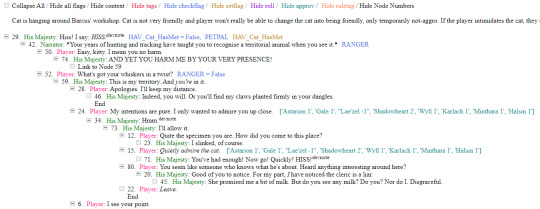
If you want to run the parser yourself instead of downloading my parsed files, it's easy:
run bg3dialogreader.exe, OPEN any .pak file inside of your game's '\steamapps\common\Baldurs Gate 3\Data' folder,
select your language
press ‘LOAD’, it'll create a database file with all the tags, flags, etc.
Once that is done, press ‘EXPORT all dialogs to html’, and give it a minute or two to finish.
Find the parser dialogue in ‘Dialogs’ folder. If you move the folder elsewhere, move the ‘styles’ folder as well! It contains the styles you need for the color coding and functionality to keep working!
New features:
Once you've created the database (after step three above), you can also preview the dialogue trees inside of the parser and extract only what you need:

You can also listen to the correspinding audio files by clicking the line in the right window. But to do that, as the parser tells you, you need to download and put the filed from vgmstream-win64.zip inside of the parser's main folder (restart the parser after).
You can CONVERT the bg3 dialogue to the format that the Divinity Original Sin 2's Editor understands. That way, you can view the dialogues as trees! Unlike the html files, the trees don't show ALL the relevant information, but it's much easier to orient yourself in.


To get that, you DO need to have bought and installed Larian's previous game, Divinity Original Sin 2. It comes with a tool called 'The Divinity Engine 2'. Here you can read about how to unstall and lauch it. Once you have it, you need to load/create a project. We're trying to get to the point where the tool allows you to open the Dialog Editor. Then you can Open any bg3 dialogue file you want. And in case you want it, here's an in-depth Dialog Editor tutorial. But if you simply want to know how to open the Editor, here's the gist:
Update: In order to see the names of the speakers (up to ten), you can put the _merged.lsf file inside of the "\Divinity Original Sin 2\DefEd\Data\Public\[your project's name here]\RootTemplates\_merged.lsf" file path.
Feel free to ask if you have any questions! Please let me know if you modify the parser, I'd be curious to know what you added, and will possibly add it to the google drive.
2K notes
·
View notes
Text
No Sugar Tonight 5
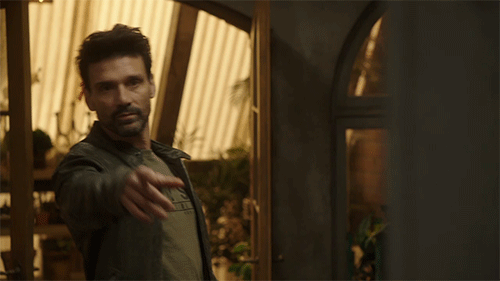
Character: Brock Rumlow
Summary: A regular customer becomes more than just a familiar face.
As usual, I would appreciate any and all feedback. I’m happy to once more go on this adventure with all of you! Thank you in advance for your comments and for reblogging ❤️

The townhouse is big compared to your apartment, though most places are. Brock keeps his hand tight on yours as he brings you up the front steps. He punches a code into the lock, the numbers blocked out by his large figure. You teeter on your feet as he pushes down the lever and shoves the door inward.
He points you in ahead of him and adjusts the straps of the duffel bag hooked over his shoulder. Those are your things, parsed down to a single bag. He follows you in as your eyes skimp the walls. Despite your muddled fear, you can’t help but stand in awe of the antique panel and brick.
“You seem like the old-style type,” he plops the bag down on the wooden bench against the wall, “shoes.”
You look down and nod. You kneel to unlace your work sneakers and put them on the rack. He sits beside the duffel as he works at loosening his boots.
You tear your attention from the tear drop bulbs of the chandelier light above and look at him. Like really look at him. He’s in all black like always. His hair is a similarly dark hue and a shadow of stubble never leaves his square jaw. His shoulders are broad and straight and even sitting, he looks huge. He looks up and narrows his eyes as he catches your gaze.
“Sir, er, Brock,” you twist your palms together.
“Yes, baby,” he sits up, his shoulders squaring. The pet name tweaks in your stomach.
“Erm...” you peer around. “I... I don’t know.”
“You don’t like it?” He stands and you take a step back. “We can update it.”
“Um, no, it’s... pretty but... what... what am I doing here?”
He snorts. It’s as close to laughter as he’s come.
“Whatever you want, baby.” He nears and reaches for you. You wince as he cradles the back of your head and draws you close. “It’s our home, we make the rules.”
He bends and kisses your forehead. You gulp as the heavy scent of his cologne strangles you. His fingers curl into your scalp and he hums. He hesitates for just a moment before he pulls back.
You suck your lip in under your teeth and turn away. You’re buzzing from his proximity. The way he crowds you is unnerving. Everything about him is.
You sense him watching you as you tiptoe around the bottom of the staircase and stop to stare at the framed painting of a woman in 19th century garb. She seems familiar as she sits on a stool in flowing ivory and pets a lamb, her stomach swollen with child.
“Like I said, you can change it,” he grits as he comes closer. “Have a look around. Explore. It’s all yours.”
You flinch and bat your eyes at the picture. This is real. You peek over at the duffle bag as the horror rolls up your spine. You don’t think you’re ever going back to your old life. This man won’t let you.
You continue down the hallway next to the stairs if only to get space from him and your looming fear. You turn to look into the den. A long sofa and cushy armchairs, bookcases on either side of the vintage fire stove and a rustic rug across the aged wooden floor. You can’t deny that it’s cozy.
He lurks like a shadow but allows you enough space to make your own way through the place. The kitchen is wrought in walnut and iron. A gas stove, a black fridge, and a dishwasher to boot. The walk-in pantry is stocked to the ceiling. You back out as he leans in the crook of the counter.
“There’s more upstairs, baby.”
You take his subtle directive and retrace your path. The dining room on the other side of the stairs gets only a quick glance before you climb to the next floor. Another hallway with several doors. A bathroom with a clawfoot tub and separate shower booth, a linen closet, and office, and the main bedroom. You stop in the last and stare at the four-postered bed.
You retreat and pass Brock as he stands against the wall, halfway up the stairs. There’s another door but it doesn’t open. You don’t try to get past the lock. You go back to look down at him.
“It’s nice, er... Brock.”
“All for you,” he turns and climbs up patiently.
“I--” your wring your hands, “really?” You look one way then the other, “thanks, but...”
“You shouldn't chew your lip. It’s already chapped.” He grabs your hands and pulls them apart, “stop picking at your nails.”
“Sorry, I--”
“Don’t be. I’ll take care of ya until you take care of yourself,” he brings your hands up between his, grazing his calloused skin over yours. He turns your palms to his and pushes his fingers between yours. His cheek dimples and he guides your hands to his chest. “You’ll be safe here.”
You nod and stay silent. His warmth seep through his shirt into your hands. It adds to the sheen of sweat speckling over your body. That fiery heat of fear, the nip of the inevitable. You still can’t wrap your head around it all but you know deep down, you’re not going back to your boxy apartment.
#brock rumlow#dark brock rumlow#dark!brock rumlow#brock rumlow x reader#series#drabble#crossbones#no sugar tonight#mcu#marvel#avengers#captain america
186 notes
·
View notes
Text
I've spent an inordinate amount of time parsing the few examples we have of Old High Gallifreyan text, and here at last is the result of my labors!
The Old Gallifreyan alphabet:
The alternate forms of letters may be used interchangeably with their main forms; the differences are purely cosmetic, much like the difference between cursive and print-style writing.
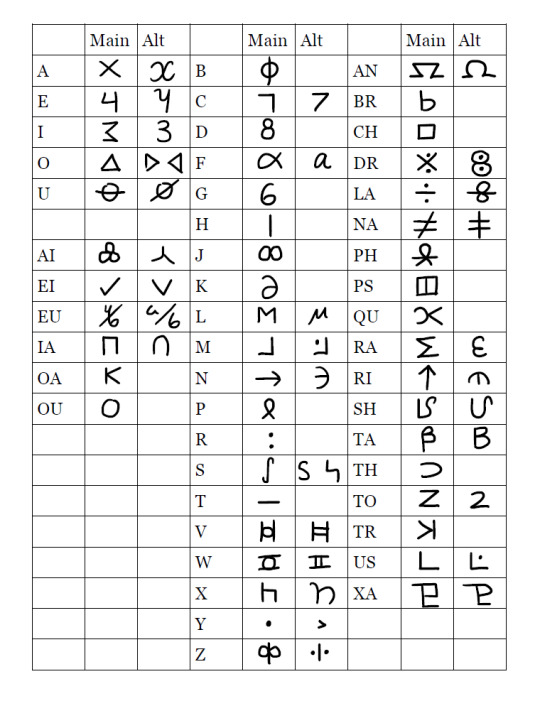
Now for my analysis of the existing texts. It's rather long, so I've put it below the break!
EXAMPLES OF OLD HIGH GALLIFREYAN TEXT
ITEM ONE

Supposedly from “The Five Doctors,” though I can’t spot this writing anywhere. Translation given in episode.

ORA PSYERPA
O – honorific indicating uniqueness, may be rendered with the definite article “the”
R – combined with the definite honorific, a common abbreviation of Rassilon’s name
A – an alternate version of the possessive “ya,” used only when the possessive noun is already abbreviated
Psyerpa – a general term for harps and other large stringed instruments
Thus, the full text reads:
O-Rassilon-ya psyerpa
The Rassilon’s harp
ITEM TWO

From “The Colony in Space,” across the bottom of the Doctor’s mugshot. No translation given.

QU ETHOA TRIOUAX BRIA
Qu – This is not a complete word, merely a letter used in this case for alphanumerical file designation: note that it stands alone, separate from the main text.
Ethoa – exile
Triouax – an infinitive verb, “to persist” or “to remain in effect”
Bria – a conditional modifier used exclusively in bureaucratic contexts, implying the need for occasional update of information or policy.
This text is a record of the Doctor’s sentence, and may be rendered something like this: Exile: to remain in effect barring further review.
ITEM THREE
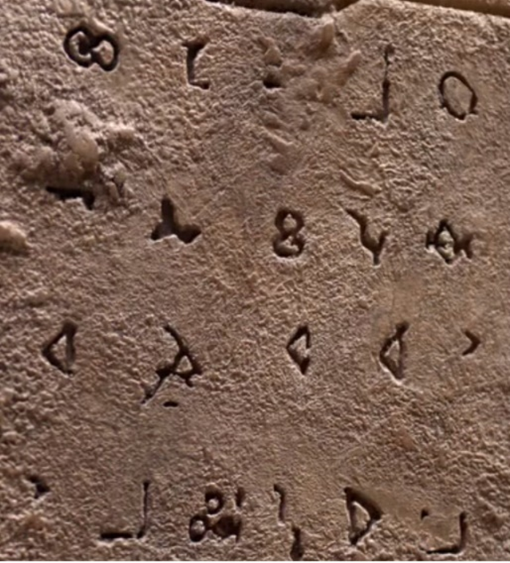
From “The Time of Angels.” Translation given.

JUSYMOU CAIDEU OXA OOYY MAISOM
Jusymou – An archaic greeting, roughly equivalent to “well met” or “hail.”
Caideu – self, soul, or “hearts” in a poetic sense
Oxa – prepositional suffix, “part of”
OOYY – a conceptual abbreviation that combines the two meanings of the solitary letter O (definite article + symbol of individuality) and the mathematical use of the letter Y (usually indicating a dimensional shift). Literally, this means something like the individual, shifted two dimensions. In practice, it refers to a Time Lord’s fifth dimensional aspect.
Maisom – name, designation, identification
Thus, a literal translation would read something like this: Greetings, soul-linked fifth-dimensional name!
Or as the Doctor paraphrases it: Hello, Sweetie.
ITEM FOUR
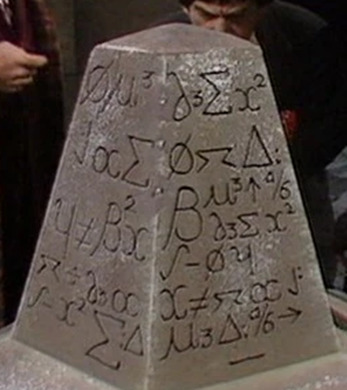
From “The Five Doctors.” Translation is given, though it’s not specified which face of the obelisk corresponds to which section of the text.
First Face:

RA NASA TO TANA EURIFSTAN OBLR ORE NATA
Ra – where
Nasa – sleep
To – in
Tana – lies, reclines, rests
Eurifstan – eternal, endless, timeless. Here it modifies the verb, so it should be rendered as an adverb.
Oblr – abbreviated form of obelar, tomb or grave
OR – the same abbreviation seen previously, “The One And Only Rassilon.”
E – an alternate version of the possessive “ya,” used only when the possessive noun is already abbreviated
Nata – a basic verb of being, is
This yields the following literal translation: Where sleep-in lies eternally, tomb Rassilon’s is.
Or as the Doctor translates it: This is the Tomb of Rassilon, where Rassilon lies in eternal sleep.
Second Face:
The text on the second face is never seen. The Doctor translates it as: Anyone who's got this far has passed many dangers and shown great courage and determination.
Third Face:

ULIREIF RAENATA TOAAN LAKI FSTA TORARO
Ulireif – to lose everything, to be utterly defeated
Raenata – an emphatic form of the being-verb nata, indicating that something really, truly, permanently is
Toa’an – to win everything, to be crowned victor
Laki – a compound conjunction combining la (so) with ki (and): “and so”
Fsta – an abbreviated form of festoa, a winner or leader
Toraro – future tense of torar, to fail or collapse
Thus: To lose all is truly to win all, and so the winner will fail.
Or as the Doctor puts it: To lose is to win, and he who wins shall lose.
Fourth Face:

KIRA ATOUNA OR TA LIRI EUKI RAATO SUTE ANAAN FEIRLIO REUNT
Kira – takes
Atouna – ring
OR – the same abbreviation seen previously, “The One And Only Rassilon.”
Ta – from
Liri – hand
Euki – a compound conjunction combining eu (then, next, afterward) with ki (and): “and then”
Ra’ato – future tense of ra’at, to wear
Sute – reward, prize, payment
Ana’an – desired, sought-after
Feirlio – future tense of feiril, to get or acquire. Note that this is an irregular verb: the last two letters switch places when adding any tense ending.
Reunt – immortality, eternity
Literally: Takes ring Rassilon-from-hand and then will wear, reward-sought will have: immortality.
Or as the Doctor translates it: Whoever takes the ring from Rassilon's hand and puts it on shall get the reward he seeks: immortality.
#doctor who#gallifreyan language#conlang#old high gallifreyan#no I have no idea how many hours I spent figuring this out#yes I'm working on figuring out the modern alphabet too (the one Four uses when he writes his letter at the beginning of Deadly Assassin)
275 notes
·
View notes
Text
According to Microsoft, "The experience supports Markdown style input and files for users who prefer to work directly with the lightweight markup language. "You can switch between formatted Markdown and Markdown syntax views in the view menu or by selecting the toggle button in the status bar at the bottom of the window. "If you prefer, you can disable support for formatting entirely in app settings."
I was all set to be angry and rant about this but then realized... eh. It's not so bad. Markup is plain ascii text after all, and you can turn the feature off. So whatever.
I just wonder WHY? Why is Microsoft wasting effort on 35 year old tools that work fine and don't need updating. They already added Copilot to Notepad. Have you not done enough?? Sheesh.
WordPad (and Write.exe) used to format using RichText (RTF) which suuuuucks. It got the job done, I guess, but it's so dang fragile. One bad byte in an rtf file caused the whole thing to unravel. I fucking hated parsing rtf files and am glad they're (mostly) dead.
Regardless, I stopped using Notepad years ago in favor of the completely free & wonderful Notepad++.
8 notes
·
View notes
Note
Do u know any reason why the Dodge Durango and Dodge Charger look kinda similar?
I see them on the streets all the time and I've noticed (at least the newer ones) have the same headlight and tail light design


Well, the short answer to that is "design language". The explanation of that short answer, however, is a bit more complicated than that, and is about why cars look the way they look - what makes them different, what makes them similar, what makes them change and how to tell them apart. So hop on under the Read More and come learn all that!
Design language is the sum of design rules and guidelines that make a brand's product range both distinct from others and coherent within itself. If you've ever recognized whose commercial it was, who printed the book, who manufactured the device, who designed the car, that was design language doing its job!
You know those "If [brand] made [thing]" renders you see out there? That's following a brand language: crossing what [thing] looks like, which is usually pretty well determined, with the much more nebulous concept of what [brand] looks like. Defining a design language is defining the answer to that second question.
So, let's look at the Dodge lineup in 2011 (the first year with both current Charger and current Durango).

There's a couple of key shared traits: the trapezoidal grille (facing downwards in 'friendly' cars and upwards in 'aggressive' ones), the small indentation in the middle of the hood, the single angular headlight housing containing two round lighting elements, and some more minute stuff. Except one of these cars features none of that, because sometimes, when updating (and, especially, when bringing back) a model, the design traits of its ancestors are taken into account, and for the Challenger, Dodge's then-current design language was almost totally disregarded in favor of faithfulness to its 1970 ancestor.


Whereas the new Charger did the exact opposite, its 2006 revival being completely based on 2006 Dodge's design language, with extremely little left of the '60s original (I see the rear window shape and the beltline if I'm being Christmas generous). Of course, this already works towards the similarity we're getting at.


But the bulk of a car's design decisions are not about design language, but about the kind of car it has to be. A designer must contend with aerodynamics, safety requirements, customer needs and expectations, with the end result being that cars of the same segment will usually end up having the same basic proportions and largely overlapping silhouettes. See the cars below:

Sure, very different styles can produce a more angular or more soft outline (see the two cars in the background), but within the same era and segment many completely different cars will be almost indistinguishable between the wheels (see the two cars in the foreground). So the most design freedom is usually found in lights and grilles, since those can be quite radically altered in shape and proportions without interfering much with functionality (unlike for example window shapes or rooflines), and even slight changes in them can alter the look and perception of a car, because we parse them similarly to faces, and thus they can make a car looks angry, sad, silly, goofy, or adorably gleeful.

So most often, the most distinctive features of a car -and by extension of a design language- are found in lights and grilles (the outline of the headlights, the inside arrangement, the grille's shape, proportion, pattern, etc.), with the rest of the car being shaped by general principles like "angular design", "simple, smooth lines" or the likes. So if you want to learn to recognize cars, lights and grilles are usually what you should focus on, as you need to be an expert for your average car's overall shape to tell you much more than its segment and decade (and perhaps market, but that's a longer conversation). That does explain, doesn't it, why lights and grilles are similar in Charger and Durango, two cars in very different segments designed to look aggressive in a distinctly Dodge way.

Let's exemplify this principle with three cars from the same segment, decade and country: In the mid-00s, Audi introduced a tall, chrome-lined downward trapezoid grille that contained the number plate; Mercedes had their classic grille -with the thick top chrome strip, small silver accents and the underlying middle line- and “merging circles” headlights; BMWs still had their staple "kidney grilles" and their quad circular headlights now contained in a wide, flat shape with round, downwards curving edges.
So even when these brands made different cars in different segments, those key traits kept them perfectly recognizable as theirs.



As you see in Mercedes, a brand's designs can get very consistent - but it can also get very inconsistent, too. For one, you don't design for a manufacturer, you design for buyers, so the design will change with who the buyers are, what they want, what they're attracted to - and when that is pretty consistent within a brand you get a lineup like Volvo's...

...whereas if you have a brand whose buyers vary wildly in all metrics that matter, you get a lineup like Kia's.

(I love this picture because you keep thinking "Well those two look similar at least" and they keep turning out to be two versions of the same car.)
The lineup's styling is also going to be more cohesive the more precious brand recognition is for it: a Ferrari needs to look like a Ferrari because that's most of why people buy a Ferrari to begin with, whereas the last time a Skoda didn't look like a Skoda it literally called for advertising.
Design languages also change and evolve with time, of course, and that's an element at play in the observation that spurred this post: Charger and Durango look similar not just because they were designed with the intention of looking similar, but also because they were updated with the goal of remaining similar, and were made even more so by the use of similar solutions to modernize their looks.

You'll notice that this was just an update of lights, bumpers and grilles - and indeed, these are what's known as "facelifts": where a new generation is usually redesigned from the ground up or retains little more than the core structure, facelifts are instead intragenerational updates that stay clear of radical changes (at most, things like hood and fenders can get updated if new headlight shapes require it).
But as we covered, those are the parts that matter - so while something as little as a facelift can be absolutely impossible to notice...


(seriously, two of my neighbors have these and it took me weeks of seeing them side by side to notice differences)
...it can also be effective enough to carry a model into a new decade...


...ore even powerful enough to completely salvage a car's design, and by extension its fortunes.


However, of course, it can wield the opposite power just as well.

Christ. Welp, no mistaking that for not a BMW now, is there. But to be clear, while BMW's styling has completely gone down the gutter lately, don't get the impression that any brand at any time is beyond a miss in this regard.

So, to close, while there is merit to the claim that cars today seem all the same, as we've discussed that's only true -and for good reasons- when looking at them from a distance. But when a landscape seems depressingly monotonous, you just have to look closer. And so, getting closer, analyzing the traits that weren't dictated by their nature, the decisions that weren't made for them by external factors, looking at what of them was shaped by agency and not necessity, they will all reveal themselves to all be different and to all have a personality of their own (bland as it may be). And that personality will change over time: changes are normal within a life, and actually good - they're a sign that life has been long enough to outlive the trends and ideas that shaped it, and that it's open to the new ones that have blossomed since. Trying too hard to fit in or stand out or seeking change for its own sake without a clear direction can ruin something good, sure, but change can also be very positive: it can allow keeping up with the times, or even a transformation for the better that lets go of what didn't work and accentuates what was good - and often, when it's done right, the world rewards it. And none of this requires a distancing from heritage or family, or even identity. In fact, as seen with our two cars, change can make a family bond even tighter.
This year will bring lots of change. Here's hoping we all manage to make it change for the better.
So yeah, hopefully that answers your question, anonymous asker who may well have fucked off to Hollywood in the over month and a half it took me to get to this (whoopsie)! Immense thanks to @ldub0775 for the effort and thought he joined me in pouring into this post, and to all followers reading this for sticking around into 2024 to witness that effort's fruits. Trust me, you will really like what's coming.
Links in blue are posts of mine about the topic in question: if you liked this post, you might like those - or the blog’s Discord server, linked in the pinned post!
#design language#car design#dodge charger#dodge durango#dodge challenger#audi#mercedes#bmw#volvo#kia#the great catchup
42 notes
·
View notes
Text
I love Sentinels of the Multiverse. For those unaware, it is a cooperative card game where you play as a team of heroes against a villain who "pilots themself". It's set in the fictional comic universe (as in comics are fictional, and the existence of these comics is also largely fictional, you know, a meta fiction scenario) of Sentinel Comics which comes complete with all the comic book tropes and story lines you can find in Marvel and DC. They have amazing character concepts, each with their unique approach to playing the game. I love everything about it. They ended with a major multiverse threatening story line before calling that the end of the card game. Then, a few years back they announced that they would be re-releasing the game with some streamlined rules and updated illustrations. Okay, cool. I can get behind that. The first set released, not significantly different than how the original game played, but there are a few less ambiguities. That's always nice. Then they announced the first expansion for the definitive edition. This time with a new hero and new villains. I wasn't thrilled that they were adding new content when there was no indication this would be anything but a remaster of the original game, but it was also exciting that we would be getting new content for a game that I believed had ended. So a bit of a wash on that one and the excitement for new stuff won out for me. Now we are in the waiting phase of the second expansion. This one also brings with it a new hero (hero pair to be precise) and new villains. There was something that seemed off to me during the fundraising campaign and then as time went and I couldn't shake that feeling I kept looking at the card and art previews they had given us. That's when it struck me. What was bothering me was in the art. The game has art that pays homage to the general style of comics through time, but what I would describe as the "modern comic" art is where I continue to dwell and think about it. That particular style of art is doing what I can only describe as "homogenizing".
There are two particular characters where this really stands out to me. The first of which is Parse. Here is what she looked like in the original printing of the game.
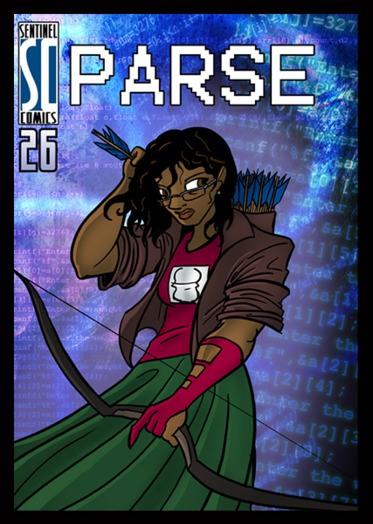
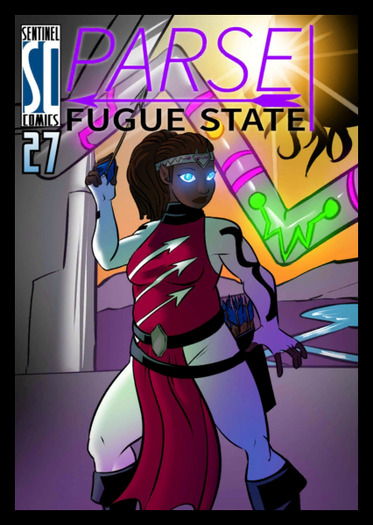
I like her design, I think she looks super cool! Then in her alt art you can see she's a bit on the fatter side (by comic standards anyway, she realistically just has human proportions there). That's cool to see in a riff on the comic genre. Take some things that aren't seen as much and bring them front and center! I love that. Then there is her new art for the definitive edition.
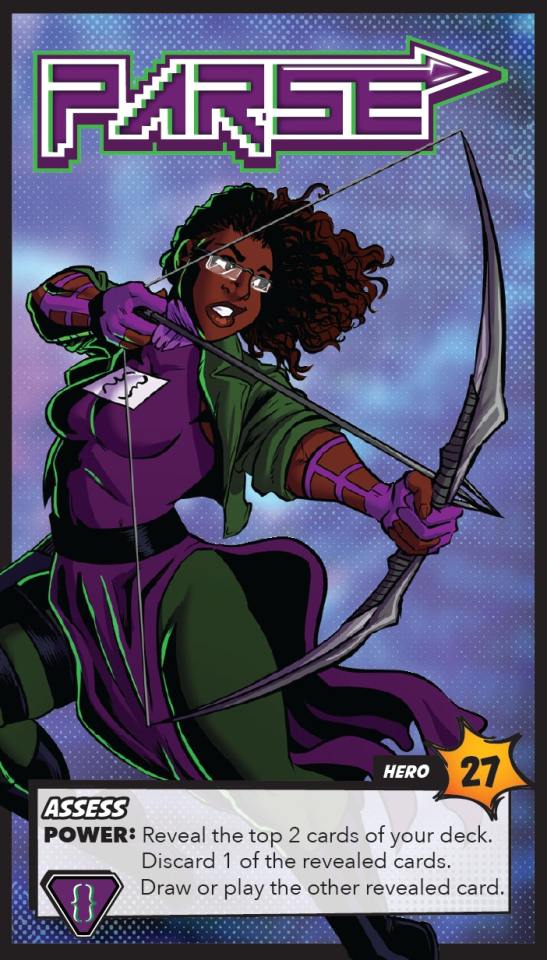
I feel like her costume really just became "skintight female hero outfit". I think it really detracts from the character of her original costume. I also think she looks on the skinnier side, but the same could be said of her first art from the original game. Then there is the villain character, Apostate.
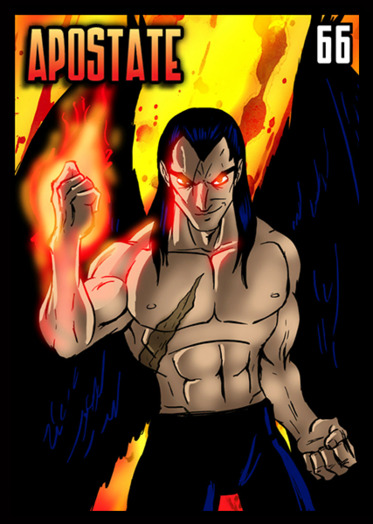
He's grizzled, he's buff. He looks like you're in for a bad time fighting him. Then updated:
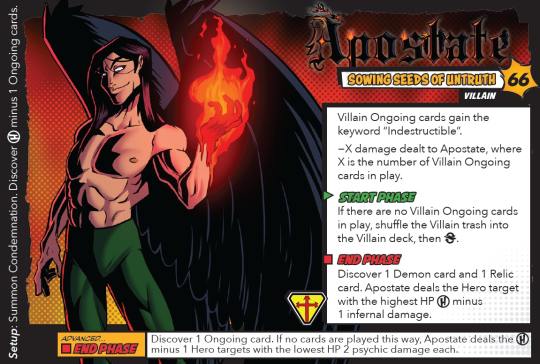
What happened to his wrinkles? What happened to his extreme widows peak? The defining features of his face are gone and replaced with a younger, prettier man. This somehow makes him less sexy. My understanding is it's to display he's more about scheming than kicking your ass directly, but I also can't over the look he's giving the viewer. Now he looks like you would have a bad time fighting off the invitations to the bedroom he's trying to get you into.
These are just the examples that irk me the most. There seems to be a general trend in the game's art that leans into these young, pretty, triangular sexless men and these skin-tight suited, buxom, skinny ladies. It's homogenizing to the worst form of comic art. A style I would describe as "Liefeld-esque" It bugs me that all the character in the designs is being taken out and replaced with such generic "comic art". Anyway, just keep thinking about that and wanted to send it to the void.
11 notes
·
View notes
Text

TL;DR version: My card game, Jewel Thief, can be played for free by following the downloadable rules available on the shop page and with a regular deck of cards (look for 🍕 under the fold to learn how). I'm pleased with the review it received and plan to address the critiques in a second edition in the future (maybe).
Posting about my card game, Jewel Thief again. A review for it went up, so figured now would be a good time (even tho I’m 2 months late cause the review went up in July -_-). I won’t explain the game again; check out this post if you want to know. The gist is that it’s a competitive card matching game with four variants.
There’s another review that hasn’t gone up, yet so I might make another post or just update this one idk.
First thing’s first, thank you to Michelle Ridge of Board Game Quest for reviewing my humble card game. Her review gels pretty well with my own opinions on the game, honestly. Click the previous link to read it.
Her main critiques were:
Gameplay may become stale over time
Rulebook style may be hard to parse
Playable at two but not exciting
But she seemed to generally like it; which is great! I’d like to address her cons in a potential expansion/second edition; thinking about some kind of 2+ player battle mode or somethin’ idk for points 1 and 3, and I kinda-sorta addressed the second point just recently by uploading downloadable rules to the game’s shop page. I agree with her on it being difficult to read, as it uses a retro-style typeface for its text in which letters overlap and blend together. As the only way to purchase the game is online for the foreseeable future I think digital rules is a fine solution for now, though I would like to play around with the manual’s formatting and whatnot. 🍕 Speaking of downloadable rules, tho; you can easily play the game using a regular deck of cards by removing the Jacks, Queens, Kings, and Jokers and matching the numbers during gameplay. Just designate a number as the diamond if you play game 3 and you're good to go.
I want as many people to enjoy the game as possible, so I hope you give it a try; and, if you enjoy it, let other people know about it. For now-
Peace
#bugbeast games#card games#tabletop games#indie games#pixel art#artists on tumblr#party games#board game design#free game#print and play#family game night
20 notes
·
View notes
Text
So, I want to start posting more long(ish) form blog-style stuff here on tumblr, about my life, my recovery from depression/anxiety, updates about what I'm working on, mental and physical wellness habits, etc., and I'm trying to decide if I want to have that on a separate blog and keep this blog mainly about writing and art.
On the one hand people who follow me for the writing and art stuff may not be interested in the more personal stuff or the wellness stuff, and I don't want to like undercut or dilute the Her Broken Magic content and make it more difficult to parse out because tumblr is now dogshit at blog organization,
but on the other hand having everything be in one place would be helpful to me I think, and it's all going to bleed into each other anyway. Like, HBM/writing/art is so deeply entwined with my personal life and my recovery journey that if I'm talking about one I'm naturally going to end up talking about the other.
Also, it's not like my blog is currently really organized and professional with the HBM stuff—it's only like 5% pure HBM content and 80% memes and "lol writer problems am I write y'all?!" (the other whatever percent is art that I reblog lol). So I don't think anyone is going to be super bothered if I start adding longer, more personal stuff.
If you have any thoughts or opinions let me know!
8 notes
·
View notes
Text
also different sort of update in relation to tmbm
I took a long break from the conlang stuff and trying to work out race names for the people in sky cotl, abzu, and pathless because I got really demotivated due to the fact that my audio processor disorder was a bigger roadblock than i thought it be and when listening to the dialogue in pathless i couldn't parse the individual sounds and syllables very well.
And then my head was spinning 'round and 'round by all the language influences people caught onto/speculated about as i was doing research.
Then i realized i was probably thinking WAY too hard about all this.
And i ended up coming up with something that pleases me. Vokara (suggested by rythuliansoup) felt a bit too plain to me despite liking it since in game it just means 'people' BUT combining it with 'sa' (mother) like in 'sa shuva' (mother eagle) to make Savokara (mother's people) I think works well with the language/culture of the game :D The only thing I'm flipflopping about it is if I should add a letter or two to it like 'Savokaran' or 'Savokarash' for a little extra flair
(I then think i can work that in with Abzu but with more of the Greek/Sumerian/Egyptian angle since the art style of the images ingame is clearly influence by those real world ancient styles..)
thoughts?
#The Pathless#the pathless game#hello void i have words#Sky's on hold simply because bigger community=more likely others have their own names (ex: Luxid) and i simply haven't asked around yet /D
3 notes
·
View notes
Text
Body Type Style Mega-Poll
I’ll take the top 1-3 results depending on how the votes shake out! When I have a full 10 options, I need more votes to get accurate data, so be sure to reblog if that’s something you do. Leave a reply if you have a different suggestion, want me to skip this batch, or demand that I do more than 3 of these.










UPDATE: Clearly Stacked Fit won, but second place is harder to parse. I’ll probably go with Hourglass just to make it a little easier on myself since they are a little closer.
17 notes
·
View notes
Note
Hihi Nali eonnie :D ((hope you don’t mind being called that
Is the English TL up on Yonder is the furthest/most updated TL available? Coz I’m all caught up over there and just got pass the solution by the Jewel of Truth TT and after reading your (very deliciously written) spoilers on all that yummy angst that comes afterwards, I really can’t wait to read it all ahhhhh
btw would you say the Korean novel has easy to read language? Like really flowery vocab or complex sentence structure vs more common words & straightforward phrasing, bc I just started learning Korean lately and I’d love to read the OG novel some day but I also don’t think one introductory course is gonna be able to tide me through like 400+ chapters of novel? 😭 yeah I just wanted to get a general idea of how challenging it’d be
oh hihihihi nonnie you just became my favorite person online today i love that <33!!
and as far as i know, yes yonder is the furthest along translation available as of right now! sorry! and i know exactly how you feel, personally i simply couldn't stand it and just,,, brute forced my way through the mtl akjsdhks
and yeah! i do think tged has a pretty simple style! sometimes the technicalities get a little too complex, tbh i did not get most of what lloyd was thinking about when he started to get into the details of his projects, but other than that i would say it's not overly complicated or flowery! even in english i think the writing style is very straightforward and easy to follow along. i think if you're thinking of reading a novel in korean without being fluent on the language this is a pretty good one to do it with!
also. the mtl is also pretty easy to parse through. i lost a couple braincells here and there but it's really not that bad. so if you have trouble reading it in korean a peak here and there to the mtl will probably help too sjkdhdskfjs
7 notes
·
View notes
Text
Xbox Adaptive Controller Hub

A dedicated page for information on the Xbox Adaptive Controller. Continuously updated. A more detailed breakdown is available past the jump.
Useful links:
Video guides to using the XAC by the MS Gaming Accessibility Team: Detailed visual breakdown on how to use the various XAC features, easier to parse and find info than the dedicated support pages.
Xbox Adaptive Controller Input Device Specifications: Specs on how exactly the ports on the XAC are wired, what inputs are supported, and how they connect to TRS and TRRS connectors. Useful for making custom switches/potentiometer based devices for the XAC.
OVERVIEW The Xbox Adaptive Controller is essentially a hub for pairing multiple input devices into a which output as a regular Xbox controller. The advantage of this is more flexibility in what devices and games you can connect to, without a reliance on separate software.

For example, you could use the USB inputs on the side to attach joysticks to emulate each analog stick, with other individual buttons controller by various other styles and sizes of switch.
Because this is a hardware solution, it can also be used on various other platforms by using converters. For example, you could use a Mayflash Magic S adapter to play on Switch or PS4.
The various 3.5mm jacks on the back also correspond to various inputs, so they can be switched on the fly by simply plugging them into a different port. Each of these ports can also be reassigned using the Xbox Accessories app on Windows or Xbox, and up to three profiles saved to the controller itself--not including the default, unchanged profile.
USB Port Mappings
There are two USB ports, one on either side, and which one you plug a controller into will decide which analog stick it is mapped to, and what the corresponding buttons do. Controllers must be D-Input/HID joystick protocol, meaning no Xbox controllers or controllers reading as x-input are supported. PS4 devices are also generally not supported, though if it has a PS3 compatibility option that may work.
The first 8 assigned buttons will be mapped automatically. These buttons can be remapped, but there will be some overlap on each USB port, and the available buttons CANNOT be reassigned. You'll want to know which buttons are available beforehand. Directional hatswitches/dpads will also not be assigned, unless they read as individual buttons.
The default mappings are show below.


You can see that each side shares the X1, X2, Menu, and View buttons, though with each flipping the 1,2 and 7,8 assignments.
NOTE: Reassigning the Menu and View buttons will NOT reassign the corresponding buttons on the XAC unit itself. So if you're ok accessing those buttons through the hub you can essentially treat those as two extra wild card buttons (X1 and X2 are the other wild cards).
Supported USB Controllers:
A list of controllers I've personally found to work with the XAC.
-8bitdo Lite 2: left analog, face buttons and shoulder buttons available. Triggers unmapped. (8Bitdo Lite does not work).
-Brook Fightboard PCBs: XB Fighting Board not compatible. PS4 compatible PCBs can be used by assigning the directions to Left Stick and making sure it boots up in PS3 mode.
-GP2040ce Advanced Breakout Board. Can be used by assigning the directions to Left Stick and making sure it boots up in Dinput mode.
-Logitech X52 HOTAS: analog axis, trigger, pinky and top buttons, as well as T1/T2 buttons detected. No twist axis or hat switches. Must be plugged into throttle to function, but no buttons or axes on the throttle are detected.
-Saitek AV8R-01 HOTAS PS3 Edition: analog axis, trigger, top buttons as well as T1-4 detected. No twist axis or hat switches.
-Thrustmaster T16000 HOTAS: analog axis, trigger, top buttons as well as the top button row on the left side, and rightmost button on the row below are detected. Function buttons can be switched by toggling the left/right handed switch on the bottom of the stick.
2 notes
·
View notes
Text
i’m constantly reminded of mortality, and it doesn’t bother me the way you’d think
repost from that time i deleted an article i spent 4 days on T-T actual post this time since i somehow posted it privately yesterday 😭
---
Hi, I’m Questioning. And I like to waste my life away dedicate my free time to random hobbies that catch my hyperfixation interest on the fly. Currently, I’ve returned to something most important. Updating the encyclopedia-esque database of AlternativeTo.net. o_o
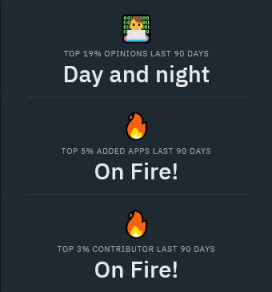
Let me finish.
See, I started exploring the world of Visual Novel (VN) makers, which led to me discovering the world of Interactive Fiction (IF)–their predecessor afaic. And that’s where it got strange. What I’ve found is interesting developments in terms of innovation and such. Like Undum (image)–“a game framework for building a sophisticated form of hypertext interactive fiction” according to its GitHub. IFWiki calls it “an authoring system for CYOA-style stories playable on web browsers.” It was created by I.D. Millington in 2009, released in 2010, had returned in 2018, and would’ve changed the IF genre (kinda like Twine did) if not for how hard it was to get into.
Undum’s flexibility and power have made it the engine that drove some of the most significant works in IF (The Play, Almost Goodbye). But it has always been relatively inaccessible. Undum is not the system of choice for writing straightforward hypertext games; it’s a challenging system to learn and use that demands the author build their own engine on top of it to drive their game logic. Consider Raconteur for “Undum with batteries included.” -Bruno Dias (x)
Enter Raconteur, “a friendlier way to write Undum hypertext fiction” that was announced by Bruno Dias in 2015. More accurately described as “a library of Undum tools that can get someone writing their story quickly.” Here’s the thing about the “library of Undum tools” part: Undum did not come prepackaged with any… even though they were required to write your game,…😐 which “meant doing a lot of your own tooling.” 😑
Yeah, no surprise it won the award for Best Technological Development in XYZZY Awards 2015.
But hold up, somethin’ ain’t right…
Undum’s only got 21 games on IFDB.org and Raconteur’s got 4… with 1 overlap with Undum. 😐
So~… wth?
Well, someone else had a similar question on intfiction.org in March and got Josh Grams’ opinion on it: JavaScript.
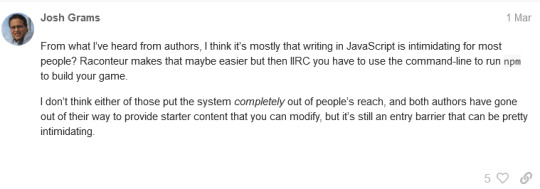
🤷🏿♂️
So even though Undum was designed as the visual version of bookbinding and with the specific goals “aesthetic” & “technical” in mind, shit’s too intimidating compared to alternatives.
I hoped [writing Undum in JavaScript] would make it accessible for a wider range of dabblers, requiring transferable skills rather than learning a new language. It also made it achievable to write and document over a few weekends: I didn’t have to worry about parsing, or creating a complete runtime. But the best benefit, and in some ways the one least exploited in practice, is the ability to use Undum as part of a bigger game. I imagined a strategy game with CYOA elements, or a piece of interactive fiction using natural language generation to be different each time. -Ian Millington (x)
And here’s~ where it gets a bit fucked.
Remember the other person who had a similar question–J. J. Guest? Well, they ended their post with “Was it simply superseded by Ink / Inky?”

Let’s keep this simple:
Ink [image] is the core narrative engine itself, written in C#. It includes the code for the compiler. If you’re not technical, you don’t need to worry about this. Inky [image] is our ink editor, which is a text editor with support for playing as you write. If you’re just starting out with ink, this is all you need. inkle is the game development studio that created ink (x)
So it’s “a narrative scripting language for games” and yet another CYOA maker. Why do I bring them up? Well, Inkle (the company) “was founded in 2011 by two Cambridge game developers [Joseph Humfrey & Jon Ingold] with a passion for storytelling and beautiful design” (x). They started off with their unique “inklebook” format, which had an early prototype game in ~2008 that Jon described as
an iPad-based choice-driven story made of ‘pages’ which stitched together into a single flow via frequent choice points. It was a lovely UI for a choice-based game, even in prototype form, and we had a strong scripting language underneath it – the first version of ink. (x)
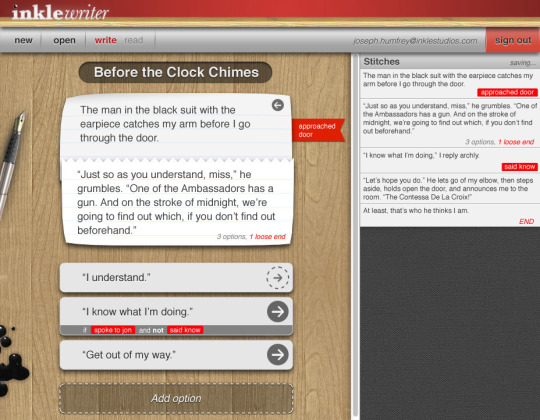
In January of 2012, they released “a web-tool for writing and reading simple interactive stories” called inklewriter. Joseph described it as “a simpler subset of the inklebook format” (x) and admitted “inklewriter was partly born out of the surprise that there isn’t anything out there for quickly and easily writing non-linearly.” (x)
After already having “moved away from developing inklewriter for a long time,” it went “permanent beta” in September of 2017 due to “increasing frequency of persistent bug-reports.” Sad news considering the statement “we’ve had hundreds of thousands of stories created by hundreds of thousands of users; we’ve won awards from school and library associations; and hopefully we’ve helped kickstart a few interactive writers careers” (x). And since writers (who became aware in time) were able to “rescue” their story from the bugs and potential wipeout with a simple Save Page As, it was probably a bit less heartbreaking when inkle revealed less than a year later that inklewriter would be shutting down completely in August of 2018. Seemingly because “it’s real work to fix the issues that arise” with the constant browser changes. 😐
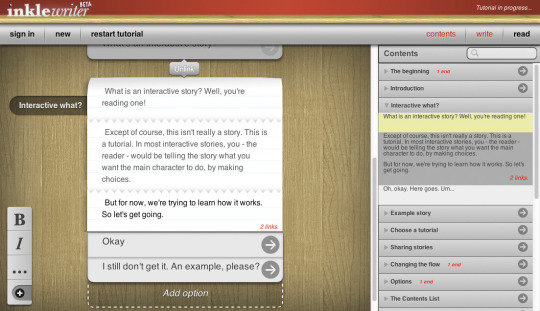
Only 7 months later, it returned in March of 2019. Stable, still free, and now open-source after developers in the open-source community “produced a full port of inklewriter to modern web-tech.” 🥳 Writers needed to make new accounts and import their stories to the new database, but that was it. And since the legacy version was (and is) still around, they could do it pretty quickly. (x)
But where dahell was I going with this? Let me tell you about the original connection first: Unity Integration.
The [ink-unity-integration] plugin provides you with everything you need to get started with ink in Unity. It automatically recompiles ink files as you edit them, and even comes with a simple previewer that lets you play stories directly within the Editor, without writing a line of code. (x)
Remember Ian Millington’s statement from awhile ago? “But the best benefit, and in some ways the one least exploited in practice, is the ability to use Undum as part of a bigger game. I imagined a strategy game with CYOA elements, or a piece of interactive fiction using natural language generation to be different each time.” (x)
Well,… Stoic Studio (announced that they) did it in January 2013 when they used inklewriter for The Banner Saga. Though, inkle recommends you use their ink scripting language instead for Unity projects. 🤷🏿♀️ A scripting language that was ported to JavaScript in May of 2016, btw. The port (inkjs) having its latest release just 6 freaking days ago while Undum and Raconteur had their last GitHub edits in 2018 & 2020 respectively.
Either way, Ian’s imagination of “a strategy game with CYOA elements” happened… with another mofo’s software. 😐
And what’s that? I left something out?
I left working on Undum to develop Varytale, a short lived commercial IF endeavour that shared a lot of the same aesthetic and narrative structure. And then I retired, and it lay fallow, aside from email help requests that still drip into my inbox. -Ian Millington (x)
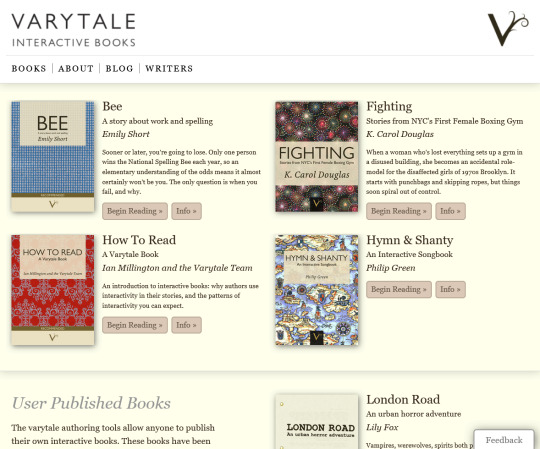
Let’s see what IFWiki says about this endeavor:
Varytale was a platform for authoring and publishing browser-based CYOA, created by Ian Millington and Alexis Kennedy; it occupied a point somewhere between Undum and StoryNexus [a comparatively mostly defunct endeavor from 2012]. The Varytale website was live from approximately 2011 to 2015. The first posts on Varytale’s blog appeared in June 2011. On March 7, 2014, Varytale posted a comment on the Varytale Facebook page saying, “The project is stalled, due to key people leaving the project. So there’s no news, and I’m not sure if or when there will be.” The last Wayback Machine snapshot of www.varytale.com/books was taken in September 2015. (x)
On its May of 2012 public beta announcement on FailbetterGames website, something slightly poignant was said.
But the technology is great [seriously] - it’s easily the most flexible and powerful tool of its kind, and it’ll be fascinating to see what people can do with it once the writers’ programme opens up. And as it happens, Jon Ingold / Joseph Humfrey’s very elegant inklewriter has also just gone live [4 months prior]. (…) …[inklewriter] covers some of the same territory as Varytale, but it’s (by design) simpler in concept and execution. (x)
Life is truly cruel.
If you check the archive from possibly days before its shut down in September of 2015, you’ll see 4 official books (Bee, Fighting, How To Read, Hymn & Shanty) and 3 User Published Books (London Road, Sixth Tower, Tillinghast). That’s 7… 7 books. 😐
But it’s not that sad. According to the Varytale blog’s 2nd to last post (in June of 2012), “we passed 50,000 reads across the seven books currently on our reader’s beta.” This was perhaps a full week after they released the floodgates and actually allowed people to start readin’. Das alot to me. They clearly succeeded in “building a platform for authors to write great books, and for publishers to publish them.” Even built a whole-ass “system that does generative design,” creating “artwork based on the author’s choice of patterned design or photograph” (x). Or, as we’d quickly say 12 years later, some AI shit.
So wut 👏🏿 in da fuq 👏🏿
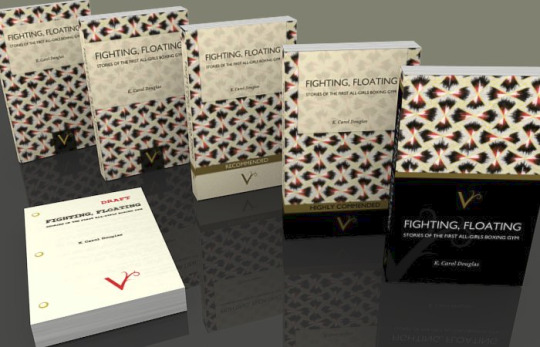
Why’d they never get past the 7 book mark in the 2 years between Reader’s Beta and project stallation? Well,… there’s a hint at the end of that 2012 blog post: “We have a queue of people wanting to write content, who are been added a few at a time. So lots of hard work in the beta still to go.” hm~ 🤔
If The Way Back Machine had archives past January of 2013, we’d definitely know more, but this is it (i ain’t diggin’ a wider hole at this point). And what is it? I think it’s a matter of workload. Too much for too few people who had however much goin’ on in their lives. Remember much earlier this bit from IFWiki?
On March 7, 2014, Varytale posted a comment on the Varytale Facebook page saying, “The project is stalled, due to key people leaving the project. (x)
Maybe things weren’t smooth enough for awhile. Maybe it was something else for those 2 years prior. 🤷🏿♂️ And you know… the end of Emily Short’s blog post Writing for Varytale might hold the answer.
There are still some challenges about using the Varytale system, though it’s evolved tremendously over the course of beta. One of the biggest authorial challenges is that, while there’s the awesome structure tool shown above for looking at branching structure inside a storylet, it can be considerably more challenging to get a view of what’s going on at the macro level. And I’m not even sure what the tool for this ought to look like. The strength of storylets is that they can affect which other ones pop up in a fairly freeform way, and one can affect another (via their shared stat use) without explicit logic in either. But that’s also what makes it really hard to graph how they will act. Most of the bugs that arose in Bee were related to this issue of envisioning the total structure of the work and detecting storylets that were going to break that structure. (x)
So in this case aswell, the innovations of Ian’s Varytale make it… (a bit) intimidating to work with. 😑Whether or not this difficulty was ever ironed out post-beta is unknown to me, especially considering the end of Ian’s thankful response to Tom H.’s suggestion for fixing the macro level problem: “When will I get chance to code it? That’s a whole other matter!”
…hm~
And on the same post lies magnus4444’s statement that “There isn’t a lot of documentation out there yet on the implementation of more advanced effects but, on the plus side, Ian is generous with advice and tips.”
🤷🏿♀️
So wtf do we have here. Effectively two developers (i’m simplifying it; fight me) who 1) made a CYOA maker (Undum & inklewriter) for very similar reasons, 2) put development aside to focus on other CYOA makers (Varytale & Inky), 3) had their neglected work taken up by open-source developers for the good of everyone, and 4) reaped the benefit of the other’s labor in some way. Now, here’s where we’re back to the sad part. Inkle’s version of the tale is the American Dream ™. Inklewriter was beloved by many and had mainstream success. Ian’s version is the harsh American Reality. Undum only bore 24+ games over the course of its 13 year existence on the internet and in the world of IF. And if a single person’s opinion is to be taken as fact… then the reason was simple: shit wasn’t easy to pickup. And thus, regardless of Ian & Bruno’s efforts, it (at this rate) is bound to become an obscure software regardless of its potential. All while Varytale remains gone and Inky (released in June of 2016) is still goin’ strong with 160+ games released using its Ink language/engine.
Which brings me back to the matter…
i’m constantly reminded of [my] mortality
#article#long post#looooooooong#Undum#Raconteur#Varytale#inklewriter#inky#inkle#AlternativeTo#Visual Novel#VN#Interactive Fiction#IF#GitHub#IFWiki.org#CYOA#I.D. Millington#Bruno Dias#XYZZY#IFDB#JavaScript#Ian Millington#inklebook#Stoic Studio#The Banner Saga#inkjs#Alexis Kennedy#Emily Short#once again i'm gonna say that i think the key reason for Ian's efforts being less successful than inkle's is marketing
1 note
·
View note
Text
Note: some changes were made for screen readers to properly parse words. The original style generally is all lowercase and uses shorthand like "abt" instead of "about", "w" for "with", and "ik" instead of "I know"
[ID 1: A reddit post titled, "AlTAH for 'training' a guy 'like a dog'?" that reads:
I (23F) have recently started seeing this guy (26M). he's super pretty, but he's kind of emotionally unavailable and he's alluded to an unstable/unhealthy childhood.
for context, i also work with socializing abused and neglected dogs at a local shelter and i think how much time i spend with the dogs is impacting the way i interact with ppl.
when we were on a date i started subconsciously making mental notes about him like the notes id make abt a dog. for example, i noticed when we went out to dinner i noticed he ate really quickly and was very anti-sharing (resource guarding) but when i offered to pay and suggested dessert it seemed to make him really happy and a little calmer (food-motivated); he's really particular about his car (territorial/crate aggression); he likes when i pick where we go/ what we do (eager to please), etc. so, ive started using the tactics id use on a dog with similar problems.
recently a friend (22F) pointed out that it's weird that i keep peanut M&Ms on me w the specific purpose of offering the guy one when i see him, and offering them again whenever i can tell he feels vulnerable. she said that im being an asshole bc he's a person, not a dog so i shouldn't be "training him like one."
i don't think that's fair, im not trying to control him or anything, i just want him to feel comfortable w me the same way i need the animals im helping to be comfortable with me. humans and animals aren't THAT diff after all, we all just want to feel safe and cared for. the guy hasn't noticed yet as far as i can tell. the problem is, my "technique" is yielding really positive results.
AITAH? should i stop?
/End ID 1]
[ID 2: Screenshot of an edit to the previous post that reads:
[start all caps] Updates / Clarifications [end caps]
for everyone asking me if i've seen the big bang theory episode with this plotline: i have not
for everyone saying they think i am autistic: probably, yeah. i haven't been tested but maybe i should
i do not have loose m&ms in my pocket bc then they'd get all melty and gross - i keep them in a bag in my purse
I know the title was clickbait-y so i want to make some things clear. i didn't think of it as "training" til my friend said it was like i was training him, and that made me feel weird (and it's why i made the post)
i am not and never have been trying to "modify" behavior. what i noticed in him and what i notice in animals were stress responses. we only get aggressive over our food if we believe someone's gonna take it away. we get defensive over our spaces if we reasonably feel like they'll be violated. applies to both animals and ppl. i was trying to establish trust the way i best know how to lol
if he never shared fries and never wanted to park next to a car with wide doors again, that'd be fine w me tbh. i know he's not a dog, so he's not at risk of being euthanized or something
/End ID 2]
[ID 3: Continuation of the above edit:
[start all caps] On to the update proper yay! [end all caps]
so, to all the ppl who told me i should tell him what im doing - you were right and that's what i did. turns out i was [start all caps] very wrong [end all caps] about him not noticing what i was doing - he apparently put two and two together pretty quickly after i started doing it. he didn't tell me he was on to me tho, because he liked it and was worried id get embarrassed and stop if i knew that he knew. so we talked it out and it ended up not being a very big deal at all and im probably gonna keep having m&ms because they're good. that's all i got for yall lol
/End ID 3]

sickens me to my stomach. how dare this guy get to live my dream.
161K notes
·
View notes
Text
How to Use Resume Suite’s AI-Powered Resume Import Feature
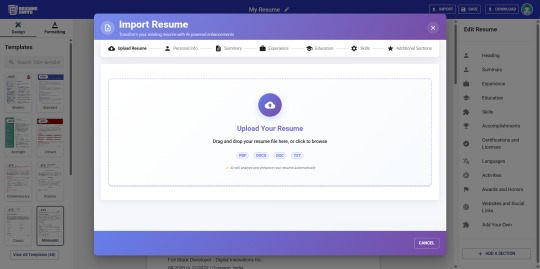
In today’s competitive job market, crafting a standout resume is crucial. However, writing or updating a resume from scratch can be time-consuming. Resume Suite’s Import feature streamlines this process: job seekers, recruiters, and career coaches can upload an existing resume (PDF, Word or text) and instantly leverage AI to improve it. AI-driven resume tools are known to “extract relevant information” and format it professionally, saving hours of manual editing. Below, we explain each step of the import process and how AI transforms your resume — from parsing and formatting to content optimization and targeted tailoring.
Getting Started: Importing Your Resume
youtube
Supported Formats: Resume Suite accepts all common resume files. You can upload a PDF, Word document (.doc/.docx), or a plain text (.txt) file. (In fact, many parsing tools explicitly support “DOC, DOCX, RTF, TXT, and PDF” formatshelp.vincere.io.)
How to Upload: Click the Import Resume or Upload button in Resume Suite. Use the file selector or drag-and-drop your resume file from your device. (Some tools also offer LinkedIn import, but Resume Suite focuses on file upload.)
Automatic Parsing: Once your file is uploaded, the system immediately reads the content. Behind the scenes, AI-powered parsing software scans the document and separates it into structured fields (contact info, summary, work history, education, skills, etc.). This step “extracts key information from your resume (whether it’s a PDF or a Word file)” and fits it into a clean template. You may see a brief “parsing in progress” message; in seconds, your raw resume will reappear in Resume Suite’s editor.
By importing rather than rebuilding your resume, you save time and ensure consistency. As one resume builder puts it, you don’t have to “start from scratch” — just upload the file and let AI do the rest. After import, you’ll see your resume content laid out in Resume Suite’s interface, ready for AI-enhanced editing.
AI-Powered Parsing and Formatting
Once imported, Resume Suite’s AI automatically reformats and tidies your resume. The AI performs a parsing process similar to Applicant Tracking Systems (ATS), ensuring every detail is captured and arranged. For example, Careerflow’s resume builder explains that it “uses resume parsing software to extract key information” and apply it to predefined fields in a professional template. This means:
Structured Sections: The tool identifies standard sections (like Professional Summary, Work Experience, Education, Skills, Certifications) and places your content accordingly. If your original resume had unconventional headings or order, the AI will reorganize it into the familiar resume layout. Think of this as automatically enforcing best-practice structure (e.g. summary at top, education after work experience, etc.).
Consistent Formatting: AI checks and fixes formatting inconsistencies. It ensures uniform fonts, bullet styles, margins and spacing across the document. In practice, your imported resume is converted to a clean template so it looks polished and is ATS-friendly. As one expert notes, AI tools can “assist in formatting your resume to make it visually appealing and easy to read,” enforcing consistency in “font styles, spacing, and layout”.
After parsing, your resume content may appear slightly different — the AI has “reformatted it into one of the selected templates with the pre-defined fields”. This ensures that no text is missed by recruiters or ATS. (It’s a good idea to proofread the result: the AI may have rearranged some details, so verify that key information — like dates or job titles — transferred correctly.) Once satisfied, you can move on to the AI-driven editing tools to refine the content.
AI-Powered Content Enhancement
With the basic layout in place, Resume Suite’s AI goes to work on improving your writing and highlighting your strengths. Here’s how the AI optimizes your resume content:
Grammar and Tone Correction: AI scans for spelling, grammar, and punctuation errors. Many AI builders boast that they will “fix any mistakes in your resume” and make it sound more professional. For example, Kickresume’s AI rewriter promises to polish your CV “in a matter of seconds” by correcting mistakes and improving phrasing. Resume Suite similarly uses language models (often GPT-based) to refine sentences. Expect simpler phrasing, consistent verb tenses, and a professional tone.
Action Verbs & Professional Language: The AI suggests stronger action verbs and concise phrasing. It may detect weak or repetitive words (e.g. replacing “responsible for” with “led” or “managed”) to make bullet points more compelling. By rewriting bullet points, the AI “highlights your achievements and showcases your impact” more clearly.
Quantifying Achievements: Where possible, the AI tries to add metrics or quantifiers. If your resume lists duties, the AI can convert them into accomplishments. For example, “Improved sales” might become “Increased sales by 20%”. Many tools prompt you for numbers (e.g. how much revenue you contributed) to beef up your bullets. This practice aligns with AI resume tips that emphasize “identifying and quantifying achievements in your resume bullets” for greater impact.
Keyword Optimization: To pass ATS filters, your resume must include relevant keywords. Resume Suite’s AI will scan your content and suggest missing industry terms. It can even tailor your language to each job (see next section). For instance, Teal’s builder explicitly encourages strategic keyword use, noting that it can “incorporate keywords strategically to strengthen alignment with job requirements”. The AI might underline or recommend new skill keywords that you hadn’t mentioned.
Section Enrichment: If your resume lacks a common section (say, a Professional Summary or Skills list), the AI can draft one for you. Using your profile details, it may generate a concise summary or identify core skills. Some tools automatically populate an initial summary paragraph or pull skills from your job descriptions.
In practice, you’ll see suggestions or buttons like “Rewrite this sentence” or “Improve bullet” next to each section. Accepting these suggestions will reword that part of your resume. The end result is a clearer, more polished document: one AI builder even advertises that its user’s resume will have an “extra polish” and “sound more professional” after the AI edits.
Tailoring Resumes to Each Job
A standout feature of Resume Suite’s AI is job-specific tailoring. After importing your resume, you can provide a target job title or description, and the AI will recontextualize your resume content for that role. Here’s how it works:
Enter Job Details: The tool prompts you to specify the position you’re aiming for. You might type in the job title and paste the job description, or select a saved job profile. By doing this, you tell the AI the industry and responsibilities to focus on.
AI Keyword Matching: The AI scans the job description to identify key skills, terms, and priorities. It then checks your resume against these. Many AI resume tools boast of “automatically incorporating job-specific keywords with AI to tailor your resume” for each application. In effect, the AI will highlight or suggest adding keywords from the job description to your resume bullet points and summary.
Rewriting Content: Based on the target role, the AI may rewrite sections of your resume. For example, it can revamp your summary paragraph to echo the language of the job posting. In one AI tool, simply pasting a job description lets the software “tailor your resume summary, experience, skills and achievements sections to the job… including relevant skills and keywords you missed. Another reports generating “a new version of your resume that is optimized for your desired job or industry”.
Customized Suggestions: After tailoring, the AI often shows you an updated draft. You can review changes like new bullet points, edited summary, or reordered skills. For example, Careerflow’s help center explains that its AI “helps you tailor your resume specifically to job opportunities” by adjusting suggestions based on your submitted job title and description. Resume Suite’s AI operates similarly, giving you a draft that emphasizes the qualifications most relevant to your target role.
By repeating this process with different job descriptions, you can quickly create multiple resume versions — each one optimized for a specific application. This helps job seekers maximize their interview callbacks. Recruiters or coaches can also use this feature to see how a candidate’s resume would look for different roles or industries.
Reviewing and Finalizing Your Resume
After the AI completes its edits, you’ll find yourself in Resume Suite’s editor interface. Typically, the screen is split: on one side you see the new resume layout, and on the other side an editor with tools and feedback. For example, a typical resume builder shows a resume score or match percentage, along with skill-match indicators to guide you.
Check the AI’s Work: Carefully read through each section. Make sure that all important information is present and correctly formatted. Sometimes the AI parser can misinterpret unusual text (for example, oddly formatted dates or symbols). The tool often reminds users to “go through the created resume and make the necessary changes to ensure the data you need is present”.
Accept or Edit Suggestions: The AI may underline phrases or provide alternate versions. You can click on suggestions like “Rewrite sentence” or “Improve bullet” to view its edit. Accept changes that enhance clarity and professionalism. If a suggestion doesn’t fit your experience, feel free to ignore it or adjust manually.
Final Formatting: Once content is settled, you can tweak design elements. Resume Suite likely includes template options (fonts, colors, section order). Ensure that your name and contact details are prominently placed and that headings are clear. The AI has set a solid foundation, but small tweaks (like adjusting a margin or adding a line break) give the final polished look.
When you’re satisfied, download or export the resume. Most systems let you save the finished resume as a PDF (highly recommended for universal compatibility) or as a Word file. Your imported resume is now a modern, ATS-friendly document that highlights your strengths.
Benefits for Job Seekers, Recruiters, and Career Coaches
Job Seekers: The import feature gives job hunters a fast-track to a professional resume. Instead of rewriting every detail, you start with your existing resume and let the AI polish it. This saves valuable time (many AI tools boast “time efficiency” by auto-filling details and generating content quickly. The AI also ensures your resume passes through ATS filters by applying the right keywords and format. You can create multiple customized versions for different roles, improving your chances of landing interviews. As Kickresume advertises, its AI can give your CV “that extra polish” almost instantly, meaning less tedious editing and more job applications sent out.
Recruiters/Hiring Managers: Resume Suite can also help recruiters who wish to standardize incoming resumes. By importing candidate resumes into a uniform template, recruiters can quickly compare qualifications. The AI’s parsing makes key data (titles, skills, dates) explicit, reducing manual review time. Moreover, if a recruiter recommends edits to a candidate’s resume, they can demonstrate improvements using the tool. The AI’s emphasis on ATS compliance ensures that candidates’ resumes are optimized for any systems recruiters use, minimizing lost information.
Career Coaches/Advisors: Coaches benefit from being able to show clients immediate, tangible improvements. For example, a coach can upload a client’s resume and together review AI suggestions on phrasing and structure. This makes lessons on resume writing concrete. The AI’s ability to tailor resumes to specific roles is invaluable for coaching — you can demonstrate how adding or rewording a skill can change the resume’s focus. Career coaches can leverage the “customization” advantage of AI tools, which explicitly allow tailoring by industry and keywords Instead of crafting edits manually, coaches use Resume Suite to experiment with wording, quantify achievements, and highlight strengths, guiding clients toward higher-impact resumes.
In short, Resume Suite’s import and AI features empower all users to produce cleaner, more effective resumes. By automating tedious formatting and infusing expert writing tips, the tool helps each resume meet professional standards and stand out to recruiters.
Conclusion
Resume Suite’s import feature and AI-driven editor make resume updating faster and smarter. By supporting common file types (PDF, Word, Text) and using AI to parse, reformat, and enrich your content, the tool turns an old resume into an optimized, ATS-friendly document. The step-by-step experience — from uploading a file to adding a target job and reviewing AI-suggested edits — is designed to be intuitive. Users get concrete feedback (like improved bullet points, error-free writing, and relevant keywords) that make their resumes stronger. Whether you’re a job seeker polishing your profile, a recruiter organizing candidate details, or a career coach refining a client’s CV, Resume Suite’s AI enhances every resume with professional format and targeted content improvements.
#resume#resume builder#resume suite#resume templates#resume writing services#resume writing tips#Youtube
1 note
·
View note
Text
How Direct Mail API Can Transform Your Marketing Strategy

✉️ How a Direct Mail API Can Transform Your Marketing Strategy
✅ 1. Automated & Scalable Mail Campaigns
With a Direct Mail API, you can:
· Automatically send postcards, letters, flyers, or catalogs triggered by user actions (e.g., cart abandonment, new signup).
· Scale from sending 10 pieces to 10,000+ without manual handling or printers.
Example: An e-commerce site can trigger a discount postcard to high-value customers who haven’t purchased in 30 days.
🎯 2. Hyper-Personalization
Just like email or SMS, you can personalize:
· Names
· Product recommendations
· Locations
· QR codes or discount codes
This increases engagement and conversion rates significantly because personalized mail feels more relevant and trustworthy.
📊 3. Data-Driven Targeting
Use customer data (CRM, behavior, geography) to:
· Segment your audience
· A/B test different messages, formats, or images
· Optimize delivery timing and content
Example: Real estate agents can target homeowners in specific zip codes with listings or promotions based on home value data.
⏱️ 4. Speed & Reliability
APIs like Lob, PostGrid, or Click2Mail enable:
· Same-day or next-day production and mailing
· Real-time tracking of delivery status
· Error handling (e.g., undeliverable addresses)
This makes direct mail as fast and trackable as digital campaigns.
💡 5. Omnichannel Integration
Integrate direct mail into your marketing stack:
· Combine email + direct mail in workflows
· Trigger direct mail from HubSpot, Salesforce, Zapier, etc.
· Sync with digital campaigns for consistent messaging
Example: A SaaS company might send a handwritten-style welcome letter along with an onboarding email to new enterprise users.
📈 6. Higher ROI and Response Rates
Direct mail often outperforms digital in terms of:
· Open rates (nearly 100% — people check their mailbox)
· Response rates (can be 5–9x higher than email)
· Brand recall (physical items leave a lasting impression)
🛠️ 7. Easy Integration for Developers
Modern APIs offer:
· RESTful endpoints
· Pre-built templates
· Address verification
· Webhooks for delivery updates
This allows developers to plug it into existing tools with minimal code.
🚀 Use Cases Across Industries
· E-commerce: Retarget abandoned carts, reward loyalty
· Real Estate: Send listing postcards to neighborhoods
· Healthcare: Appointment reminders, compliance letters
· Nonprofits: Donor appeals, thank-you cards
· Financial Services: Loan offers, fraud alerts
🔚 Final Thought
Integrating a Direct Mail API into your marketing strategy bridges the gap between digital automation and physical presence — helping you stand out in a crowded digital world while maintaining the power of data-driven personalization.
How Accurate Address Autocomplete API Works?
An address autocomplete API works by predicting and suggesting address completions as a user types, improving speed and accuracy in form filling. The process involves several components and data sources to provide accurate and real-time results. Here’s how it works in detail:
✅ How an Address Autocomplete API Works
1. User Input Begins
o As a user types into a text field (e.g., “1600 Amphi…”), the input is sent to the API in real-time, often after each keystroke or a short pause.
2. Query Parsing and Normalization
o The input is parsed to identify parts of the address: street number, street name, city, postal code, etc.
o It is then normalized (e.g., converting to lowercase, removing extra spaces).
3. Search in Address Database
o The API uses a massive global address dataset (e.g., USPS in the US, Royal Mail in the UK, or open datasets like OpenStreetMap).
o It queries indexed and geo-optimized databases to find the most likely matches.
4. Ranking & Relevance Filtering
o Suggestions are ranked by:
§ String match quality (e.g., Levenshtein distance)
§ Popularity of the address
§ Geographic proximity (based on user’s IP/location if available)
§ Postal code and regional accuracy
o Only the most relevant results (e.g., top 5) are shown.
5. Returning Suggestions
o The API sends back a list of formatted address suggestions.
o Each suggestion often includes metadata (place ID, coordinates, country, etc.) for later use.
6. Final Selection & Validation
o When the user selects a suggestion, a follow-up API call can retrieve the full, validated address with components like:
§ Street, city, state/province, postal code, country
§ Latitude & longitude
Timezone or district info
1 note
·
View note